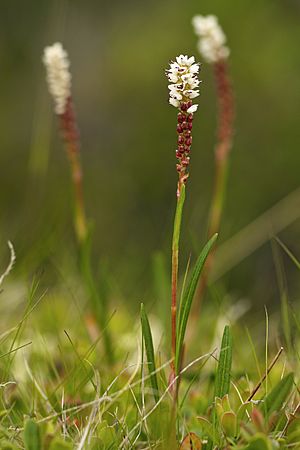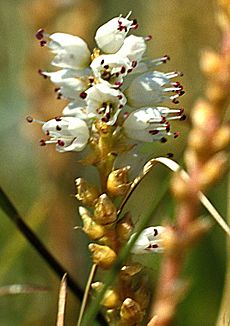Alpine bistort facts for kids
Quick facts for kids Alpine bistort |
|
|---|---|
 |
|
| Scientific classification | |
| Synonyms | |
|
The Bistorta vivipara is a small, tough flowering plant often called alpine bistort. It's a perennial plant, which means it lives for many years. This plant is part of the knotweed and buckwheat family, known as Polygonaceae. You might also hear it called Persicaria vivipara.
Alpine bistort is very common in cold places. It grows all over the high Arctic. You can also find it in Europe, North America, and parts of Asia. It even grows in tall mountain ranges. These include the Alps, Carpathians, Pyrenees, Caucasus, and the Tibetan Plateau.
Contents
About Its Name
Scientists group living things into families and genera. This helps them understand how different species are related. The alpine bistort belongs to a group called Bistorta. There are at least 42 known species in this group.
What Alpine Bistort Looks Like
Alpine bistort is a small plant, usually growing about 5 to 15 centimeters (2 to 6 inches) tall. It has a thick root system that spreads underground. Its stem stands straight up and has no hairs.
The leaves on the plant's top side are smooth. But underneath, they are a bit hairy and look grayish-green. The leaves near the bottom are long and oval-shaped with long stems. The leaves higher up are thin and don't have stems.
Flowers and Bulbils
The tiny flowers are white or pink. They grow in a spike at the top of the stem. Each flower has five petal-like parts and eight stamens (which hold pollen).
Interestingly, the lower flowers on the spike are often replaced by small, bulb-like structures called bulbils. These bulbils are very important for the plant. Alpine bistort flowers rarely make seeds. Instead, new plants usually grow from these bulbils. A small leaf often starts to grow on the bulbil even while it's still attached to the parent plant.
The bulbils are full of starch, which is a type of energy. Animals like rock ptarmigans and reindeer love to eat them. People in the Arctic sometimes eat them too. Alpine bistort typically blooms in June and July.
Where Alpine Bistort Lives
Alpine bistort can grow in many different places. It often grows in large numbers. You can find it in damp, short grasslands. It also likes yards, the edges of paths, and wet, nutrient-rich areas called fens.
Like many plants that live in cold, high places, alpine bistort grows slowly. It forms tiny buds one year. These buds then take a few years to grow and open. A single leaf or flower cluster can take three to four years to fully grow from when its bud first formed.
How People Use Alpine Bistort
The small bulbils from the lower flower stalks can be eaten raw. You can just pull them off the plant. The young roots are also safe to eat raw. Older roots should be cooked before eating. The young leaves can be eaten raw or cooked too.
In Russia, especially among the Samoyed people, the roots of the alpine bistort are an important food source.
See also
 In Spanish: Persicaria vivipara para niños
In Spanish: Persicaria vivipara para niños


